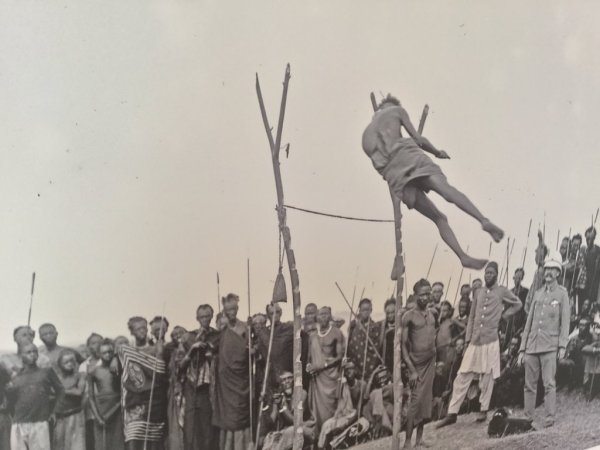In the heart of Rwanda, amidst its rolling hills and verdant landscapes, thrives a tradition steeped in history and cultural significance: Gusimbuka Urukiramende. This unique practice, involving the art of high jumping, is more than just a physical feat; it embodies the resilience, spirit, and unity of the Rwandan people. This documentary delves into the origins, cultural context, and enduring legacy of Gusimbuka Urukiramende, showcasing how it has become an emblem of Rwandan identity.
Gusimbuka Urukiramende, which translates to “leaping to touch the sky,” finds its roots deep in Rwanda’s past. Traditionally, this practice was part of the coming-of-age rituals for young men. These ceremonial jumps were not only tests of physical prowess but also symbolic gestures representing the transition from youth to adulthood.
According to oral traditions, Rwandan warriors, known for their agility and strength, were particularly skilled in Gusimbuka Urukiramende. The ability to jump high was a demonstration of a warrior’s readiness to protect and serve the community. The jumps were performed during significant community events, often as part of the Intore dance, a performance that celebrates bravery and vitality.
The practice of Gusimbuka Urukiramende is interwoven with Rwanda’s social fabric. It is a spectacle of athleticism and a profound expression of cultural values. The leap, reaching heights that often surpass the jumper’s own, symbolizes ambition, freedom, and the human spirit’s unyielding quest to overcome obstacles.
In traditional Rwandan society, Gusimbuka Urukiramende was more than just a physical competition. It served as a social barometer, where individuals showcased their strength and determination, earning respect and admiration within the community. The ability to perform a high jump was seen as an indicator of good health and a promising future.
Moreover, this tradition reinforced communal bonds. Villages would gather to witness and celebrate the jumpers, fostering a sense of unity and collective pride. The shared experience of cheering for the jumpers created an environment of mutual support and camaraderie.
With the advent of modernity and Rwanda’s evolving social landscape, the practice of Gusimbuka Urukiramende has adapted yet remains relevant. While it may no longer hold the same initiatory role it once did, the tradition continues to be celebrated in various forms.
Today, Gusimbuka Urukiramende is often featured in cultural festivals and national celebrations. It serves as a living testament to Rwanda’s rich heritage and is a source of national pride. The tradition has also found its place in educational settings, where it is used to teach younger generations about their cultural roots and the importance of perseverance.
Additionally, modern interpretations of Gusimbuka Urukiramende have emerged, integrating the traditional high jump with contemporary sports and dance forms. This fusion not only preserves the tradition but also makes it accessible and appealing to the youth, ensuring its continued relevance.
Efforts to preserve and promote Gusimbuka Urukiramende are evident across Rwanda. Cultural organizations and local communities are actively engaged in safeguarding this tradition. Festivals dedicated to Rwandan heritage often highlight the high jump as a key feature, drawing attention to its cultural significance.
On the global stage, Gusimbuka Urukiramende has garnered recognition as a symbol of Rwanda’s rich cultural tapestry. Performances showcasing the high jump have captivated international audiences, contributing to a broader appreciation of Rwandan traditions. This global interest has also sparked initiatives aimed at cultural exchange and the promotion of indigenous practices worldwide.
To understand the true essence of Gusimbuka Urukiramende, one must listen to the voices of those who participate in it. Jean-Claude, a young Rwandan who has embraced the tradition, shares his perspective: “When I leap, I feel connected to my ancestors. It’s not just a jump; it’s a way of honoring our past and inspiring our future.”
Similarly, Marie, a cultural educator, emphasizes the importance of the practice: “Teaching Gusimbuka Urukiramende to the younger generation is crucial. It’s a reminder of who we are and the values we hold dear – strength, unity, and resilience.”
Gusimbuka Urukiramende stands as a vibrant testament to Rwanda’s enduring cultural heritage. It is a tradition that transcends mere physicality, embodying the spirit of a nation that has leapt over countless challenges. As Rwanda continues to forge its path forward, the timeless practice of Gusimbuka Urukiramende remains a beacon of cultural pride and identity.
In a world where traditions often fade into oblivion, the sustained vigor of Gusimbuka Urukiramende is a powerful reminder of the importance of preserving and celebrating our cultural legacies. It teaches us that while we may leap into the future, we must always stay grounded in the rich soil of our past.
This documentary offers a glimpse into the deep-rooted tradition of Gusimbuka Urukiramende, highlighting its historical significance, cultural impact, and modern-day relevance. Through the voices of those who cherish and continue this practice, we gain insight into the enduring spirit of Rwanda.

